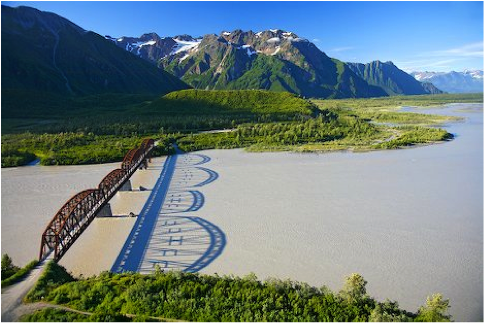Small Projects
Estimating Future Flood Frequency and Magnitude in Basins Affected by Glacier Wastage
University: Small Projects Year 1 (2012-2013), University of Alaska, Fairbanks
PI: Anna Liljedahl (UAF)
Dates: 03/01/2012 – 11/01/2013

Infrastructure, such as bridge crossings, require informed structural designs in order to be effective and reliable for decades. A typical bridge is intended to operate for 75 years or more, a period of time anticipated to exhibit a warming climate and, consequently, hydrologic changes (IPCC 2007). An understanding of present and future possible hydrologic conditions is necessary to avoid damage to critical infrastructure and costly disruptions to Alaska’s transportation network.
Phase II Structural Health Monitoring and Condition Assessment of Chulitna River Bridge
University: Small Projects Year 1 (2012-2013), University of Alaska, Fairbanks
PI: J. Leroy Hulsey (UAF)
Dates: 03/01/2012 – 11/01/2013
Final Project Report: PacTrans-13-UAF-Hulsey
In this study, we will monitor the behavior of the Alaska Chulitna Bridge for the specific purpose of assisting the DOT in performing an accurate condition assessment of this bridge.
Based on the state-of-the-art SHM knowledge and technologies with a specific interest in those which could be used on bridges in cold, remote regions, the objective of this study is to provide important information for structural condition assessment of the Chulitna River Bridge.
Investigation of High-Mast Light Pole Anchor Bolts
University: Small Projects Year 1 (2012-2013), University of Alaska, Fairbanks
PI: Scott Hamel (UAF)
Dates: 03/01/2012 – 11/01/2013
Final Project Report: PacTrans-14-UAF-Hamel
The Alaska Department of Transportation and Public Facilities owns and maintains over one-hundred high-mast light poles that are up to 170 feet tall. These poles are used to illuminate intersections and freeways in the central and south-central regions of Alaska. The poles, which are used throughout the lower 48, have experienced scrutiny in the last decade after a number of catastrophic failures across the country. As part of its review of these structures, the Alaska DOT has found widespread and continual loosening of the anchor bolt nuts at the base of the poles. The design and performance of the poles is based on an assumption of tightened anchor bolts, and the loose nuts endanger nearby traffic and pedestrians. Given their height and proximity to major roadways, collapse of these poles would likely cause significant damage and multiple fatalities.
Error Assessment of Traffic Data Devices
University: Small Projects Year 1 (2012-2013), University of Washington
PI: Edward McCormack (UW)
Co-Investigators: Yinhai Wang (UW)
Dates: 05/16/2012 – 05/15/2013
Final Project Report: PacTrans-18-UW-McCormack
The ability to produce reliable and accurate travel time or space mean speed information is becoming increasingly important in the Pacific Northwest region. New capabilities to relay traveler information to motorists through smart devices and in-vehicle systems is making such information more useful. Such travel time information is also important in determining construction delays, as well as for the purposes of signal timing and supporting congestion relief efforts.
Bicycle Route Choice: GPS Data Collection and Travel Model Development
University: Small Projects Year 1 (2012-2013), University of Washington
PI: Qing Shen (UW)
Dates: 09/16/2012 – 11/01/2013
Final Project Report: PacTrans-19-UW-Shen
Bicycle use is being promoted for a variety of social benefits. Because of the benefits associated with bicycling, jurisdictions across the central Puget Sound region and the nation have been investing in improvements to bicycle infrastructure. Academic and professional literature provides a basis for generally understanding bicycling behavior. However, less is known about the benefits of one facility type over another, or the potential inducement of new bicycle users when a policy intervention improves bicycling conditions.


